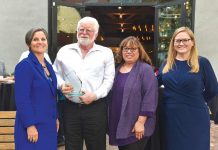With relentless reports about government shutdowns, congressional showdowns and elected officials who put the “fun” in dysfunctional, I’m hard pressed to add anything new to what’s been said 11 bazillion times already.
But did you know that an alarming number of citizens think the big governmental stumbling block, the “Affordable Care Act” or “Obamacare,” are two separate entities? I know; I’m as shocked as you are. Witness recent Jimmy Kimmel “interviews” where average folks on the street were asked if they are in favor of Obamacare. “Oh, NO!” they’ll reply. Well then; how about the Affordable Care Act? “Yes. I’m for that one. Because it’s, you know, ‘affordable.’”
So let’s move on to better news, friends, which is occurring at this moment beyond our solar system (and Washington bureaucrats), farther than any earthly object has traveled before, where a small vehicle races toward the stars.
No, I’m not talking about Mork from Ork or meteorites or space junk or anything that was jettisoned away from the International Space Station (which, by the way, was visible in our early dawn skies recently). What I’m referring to is NASA’s Voyager 1 and 2 space probes that were launched, and I hope you’re sitting down, in 1977.
That’s right. While “Laverne and Shirley” and “Happy Days,” were tops on the airwaves, and Jimmy Carter was a young pup mid-way through his first year in the White House, NASA was launching a couple of little engines that could – if you’ll forgive the simplistic comparison – via two Titan-Centaur rockets. Fun Fact: the rocket motors for the Titan launch vehicles were built right here in our own Santa Clara Valley by a company then known as United Technology Center.
If somebody asked me, and I realize they haven’t, I would say this astounding development warranted more than the two-minute blip it got on the news one day last month. What’s wrong with some astounding news for a change?
For example, these two vehicles, launched in 1977, contain some 240,000 times less memory than your iPhone. Yet they continue to send signals back to earth. Holy cow!! My iPhone may have lots of memory, but I have to charge that sucker on a regular basis for it to work. Not so for the Voyager twins.
Now even if longevity runs in your family, you probably shouldn’t expect to be waiting by your TV for Voyager to reach the nearest star; that will happen about 40,000 years from now. And, sadly, by that time the vehicle will be way past communicating with us earthlings. Voyager will have traveled too far away for further communications. As though nearly 12 billion miles, the distance it’s traveled thus far, isn’t far enough.
Voyager 1 has ventured beyond our furthest planet, Pluto, and entered interstellar space. What began as a five-year mission is now in its 36th year. I mean, we don’t expect our cars to last THAT long! So how is it that this amazing journey is still ongoing?
That’s a question that Ed Stone, chief project scientist of the Voyager for the last 40 years, could answer. He speaks excitedly about “waves in the plasma,” “solar wind tsunami” and “electron density,” all of which, unfortunately, leave my brain behind in the solar dust.
Ready for some cool science? Electricity needed by Voyager to communicate with Earth is generated by natural radioactive decay – this radioactivity being at far greater levels than humans could survive. And how does this communication get to us, you ask? Well. Through the Deep Space Network or “DSN” and no, I am not making this up.
Originally, the two Voyagers’ mission was exploring Jupiter and Saturn, which they did, returning some stunning photographs. But then they kept on going, with Voyager 2 taking a scenic tour of Uranus and Neptune. Today, that vehicle lingers about three billion miles behind Voyager 1, even though they were launched a mere 16 days apart. In 1977.
But here’s what I want to know: Can NASA build another Voyager? With, oh, I don’t know … 535 seats on board? I have some bureaucrats in mind I’d like to see on the next flight into interstellar space.













